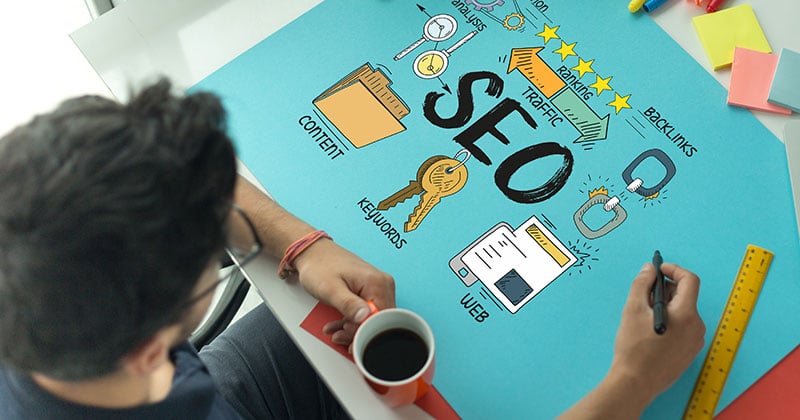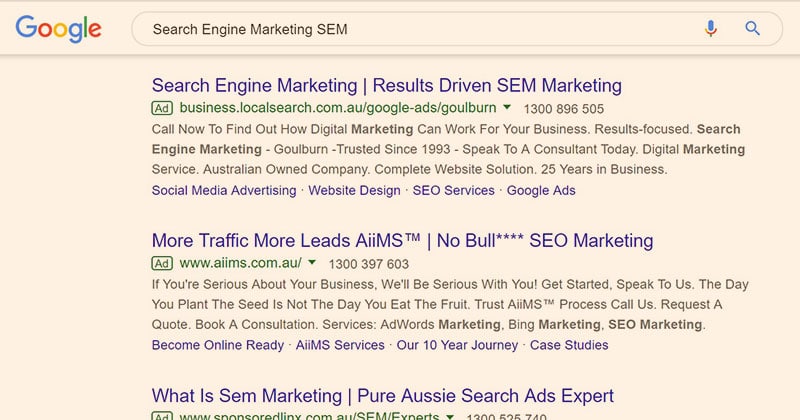Digital marketing activities are the things you do to reach potential customers on their computer devices.
Almost every digital marketing activity falls into one of six types: content marketing, SEO, search engine marketing, social media marketing, affiliates and influencers, and email and message marketing.
If you want to understand what digital marketing really is — once and for all — read on. I’ll explain in a little detail what each type is about. You’ll also get some strategies and examples on how to make each one work.
By the way, I’ve done all these activities personally for my own company. Some I’ve obsessed about, such as content marketing and SEO, while others I figured out would be better suited to other kinds of businesses.
Any career in marketing these days depends on digital marketing and doing these kinds of things. You’ll find that most marketing courses are concerned with covering at least one of these categories. A comprehensive program would try to cover them all.
This is a practical guide for anyone who wants to gain a firm grasp of the concept of digital marketing. In particular, you’ll be briefed on the different types that are available and how you could use each one to promote a brand, product or service.
1. Content Marketing

Content marketing is essential to almost all forms of digital marketing. Anything that goes beyond classic, straight-up advertising could be considered a form of it. This includes blog articles, social media posts, videos, and digital tools like calculators, along with inbound marketing and online PR.
The idea is to entice customers to discover your brand, products or services by giving them useful or entertaining stuff. You don’t just hit them over the head with traditional advertising. Great content attracts an audience of prospective customers and leads them towards a sale or other profit-boosting action.
Content can take any digital form and is often based on storytelling. You can promote what you have to offer through blog articles, guest posts, news releases, videos, social media posts, digital books, online courses and even things like comparison tools and calculators.
Your content should be informative and/or engaging so that people actively seek it out. Ideally, your role to prospective customers is seen as something more than a mere advertiser. You could instead be embraced as a helper, partner, entertainer or teacher.
Content marketing can be extremely effective because your target audience gains value from it. You are able to reach far more people as a result while winning trust and confidence. The right strategy can then convert successful audience capture into sales.
Most types of digital marketing are content reliant, including social media marketing, search engine optimisation and email marketing. Without good content, such activities become difficult and/or ineffective.
Example: Skyscraper Technique
Brian Dean’s Skyscraper Technique is a classic example of using content marketing to advance your business. In this case, the goal is to gain links and traffic by providing better content than competitors.
The technique consists of 3 steps: (i) find a web resource that has many links from other sites (ii) improve on the content that’s offered and (iii) reach out to webmasters and others who may want to link to the new, improved resource.
2. Search Engine Optimisation (SEO)

Search Engine Optimisation (SEO) is about getting your web resources towards the top of the rankings in Google, Bing, etc. SEO covers the many optimisation activities available to boost rankings. Activities such as web design, marketing analytics, and improving conversion rates often complement SEO efforts.
SEO efforts tend to focus on keywords and phrases relevant to your business. Perhaps the most basic SEO activity is to include keywords in a web page’s title and contents.
Modern search engines, powered by AI models like Google’s BERT and MUM, now prioritise understanding the intent and context behind search queries. This means your content needs to align with what users are truly looking for, not just the keywords they type.
Doing SEO well can provide enormous benefits to any business with an online presence. A high authority site can attract a steady stream of prospective customers day and night, year after year. On the other hand, a lack of SEO can mean a site is near impossible to find through organic search — the most common way to find stuff online.
SEO activities can be broadly divided into On-page and Off-page. On-page SEO covers things you do to your website (or YouTube video, etc) to increase the chances of being ranked highly. Off-page SEO refers to activities beyond the website, a key one of which is to gain links to it (backlinks).
The SEO industry has been a battleground over the years. SEO experts have exploited weaknesses in the search algorithms to rank content in clever and, often, ethically questionable ways. The search companies respond by adapting their algorithms to prevent gaming of the system and punish activities that fall outside their guidelines of proper behaviour.
While gaming opportunities and moral dilemmas still exist, the search engines are getting smarter. Increasingly, the best way to rank well is by doing what Google has asked us to do all along: provide high quality content.
Example: Guest Posting
A popular way to gain links from websites and boost your site’s domain authority is to guest post. You start by finding opportunities to write for someone else’s website. In return for giving them content, you link back to your site in the author profile or within the article itself.
To be fully effective, the link should be free of the rel= “nofollow” tag. The nofollow attribute effectively tells search engines to ignore a link. Note that paying to write a guest post would normally violates Google’s Webmaster Guidelines.
3. Search Engine Marketing (SEM)

Search Engine Marketing (SEM) is advertising based on keywords. The advertiser pays to appear in search results or in ad slots on websites. This can also include strategies like audio advertising and marketing automation to optimise ad campaigns.
For the search results page (like that in the image above), you pay for your ad to be displayed above, below or alongside the organic (unpaid) search results. Ads are currently identified by Google with a small “Ad” sign next to the url for the advertiser’s landing page.
For ads on websites, you pay to use the website owner’s advertising space. They make the space available for advertisers by installing Google Adsense or similar software on their site. Each web page is associated with certain keywords based on the page’s title and contents among other things.
To appear for a particular search term, you need to bid on how much you are prepared to pay per click for the search term. It’s not as simple as the highest bidders in the automatic auction having their ads displayed.
Google Ads gives each ad a quality score for the particular search term. The higher your ad’s score, the lower you can potentially set your maximum bid and still have your ad displayed. To score higher, your ad should:
- contain relevant text
- have a high click-through rate
- take people to a high-quality, relevant landing page.
SEM gets cheaper the more research and practice is put into it. A highly skilled marketer can buy traffic at a relatively low cost using techniques such as ad design and keyword selection.
For SEM to pay for itself, you also need a marketable product and a landing page that effectively converts visits into sales.
The cost of advertising varies greatly with the industry. There is little or no competition for some keywords. The most expensive keywords, with average costs per click reportedly above $50 USD, include “business services”, “casino” and “lawyer”.
4. Social Media Marketing (SMM)

Social Media Marketing (SMM) is about using social media platforms to gain attention and traffic. Popular platforms include Facebook, YouTube, Instagram, Twitter, Pinterest, LinkedIn and SnapChat. It also involves mobile marketing, video ads, and influencer collaborations.
You can use social media to raise the profile of your business. Social media platforms allow you to advertise your brand, products and services directly. With their “pixel”, Facebook allows you to digitally track people who visit your site and then show your ads on their Facebook feed.
As well, social media marketing is a way to reach and build relationships with prospective customers. You can publish content that is relevant to your target audience and have them engage and interact with it.
Posted content may teach, entertain or seek your audience’s attention. To work well, the digital marketer needs an excellent knowledge of the platform, including content sharing patterns, and the tastes of the target audience.
Gaining followers can be a powerful way to build a ready-made audience. However, the platforms adjust their algorithms to restrict how well unpaid posts reach audiences, including even followers. This forces companies to resort to paid advertising to get results.
Businesses that appear to be doing best in social media marketing include business-to-consumer and software-as-a-service companies. To test if a platform might work for your business, a starting point is to use it and see which types of ads appear regularly.
Example: Instagram “must have” image ads
Instagram is a highly visual social media platform. Posts consist of a large image or video and some small-type text underneath.
Retailers such as See Jane Work, which sells stylish office supplies, are taking advantage. They post beautiful images of their products, presented so that people think to themselves, “I must have that”. Instagram has shopping tag and checkout features so that, will little more than a click, people can easily buy what they see.
5. Affiliate and Influencer Marketing

Affiliate and Influencer Marketing is where you pay your partner, the affiliate, for referrals or traffic that generate sales. It’s like hiring a digital salesperson to sell your products or services. Other forms include referral programs and sponsored content.
The affiliate typically earns a certain percentage of the sale amount, such as 12 per cent, as commission. You can set a non-negotiable payment rate or, especially when dealing with a small number of strong affiliates, negotiate the rate. A higher percentage encourages the affiliate to try harder to generate sales.
Software and platforms are available where the required technical work is handled for you. Online marketplaces like those provided by CJ Affiliate bring sellers and vendors together. Affiliates tend to be the owners of high-traffic websites and blogs.
Another way to create awareness for your brand is with a special type of affiliate: an influencer. This is a famous person who has a large online or social media following.
You can increase your audience by paying or enticing an influencer to endorse your brand, product or service. Influencer-led promotions not only generate online traffic but can bring other benefits such as prestige and brand trust.
When doing affiliate marketing, you may want to set certain guidelines to help maintain brand integrity. At the same time, it’s good to give the affiliate enough freedom to connect to their audience using their proven style. Affiliate marketing works best when the promotion activity seems like a genuine endorsement and not just a paid ad service.
Example: Amazon Associates
An example of effective affiliate marketing is Amazon’s program, called Amazon Associates. After a quick signup process, bloggers can place links on their website that take potential online shoppers through to products in Amazon’s enormous online catalog.
To make money, bloggers generally have to work hard to create custom pages, often product review pages, that endorse or showcase Amazon items. The traffic generated looks to be cheap from Amazon’s perspective. The online giant merely promises that you can earn “up to 10%” in advertising fees.
6. Email and Message Marketing

Email and Message Marketing is where you market to a prospective or existing customer directly by email or other message channel (such as text message or via Messenger). If you don’t have the recipient’s authorisation to contact them in this way, email and message marketing is called spamming or sending junk mail. SMS marketing and automated email responses are common examples.
Ideally, each recipient in a marketing campaign has given their address freely and is unsurprised to receive correspondence from the sender. Each email or message should always give the option to unsubscribe or otherwise elect to not receive further emails from the sender.
Having your outgoing emails labelled as “junk” by multiple receivers can cause problems for your business. Email blockers may prevent some or all emails from your address getting through to intended recipients. Authentication standards such as DKIM and SPF help ensure that your business is able to send emails without being stopped by filters.
People are understandably hesitant to share their contact details these days because of spamming. But a way to overcome this is to offer something valuable in exchange. This could, for example, be free eBooks or downloadable guides or other information.
Email and message marketing can have a huge payoff when applied to known customers. These might be people who bought your products or services before, or who registered to buy but didn’t actually go through with the transaction. An email about a product or service they showed interest in, especially coming from a business they are familiar with, can easily remind or encourage them to make a repeat or initial purchase.
You can also promote a brand, product or service through content marketing by email. Subscribers to newsletters, blogs or other information services are at least somewhat receptive to useful content. You can promote products and services in emails, and include commercial offers, while providing value to the subscriber group.
Example: Airbnb
If you’ve ever used Airbnb accommodation, you would be familiar with their email marketing. Actually, their emails don’t feel like a marketing campaign, which shows the company is succeeding at digital marketing.
Airbnb uses perhaps the most important strategy in email marketing: personalisation. Because they use your name, are informal and talk about your recent or upcoming trip, it feels like a message from a friend or acquaintance instead of a business. At the same time, they are quietly reinforcing their “friendly” brand and reminding you that their services are available for your next trip.

how to do email marketing ….if you have any video or link then please share
Excellent reading as an introduction to digital marketing, its various forms, and its advantages for long-term business success. Regards for that.
Great read regarding a brief overview of digital marketing and the different types as well as the benefits for continued business success. Thanks for this.